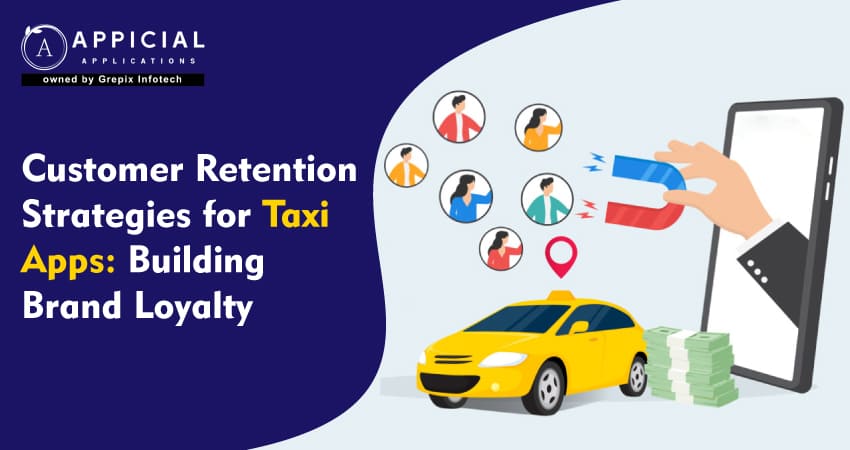
Customer Retention Strategies for Taxi Apps: Building Brand Loyalty
Let’s imagine!
It’s pouring rain, you're late for an important meeting, and all the taxis seem to have vanished into thin air. Just a few years ago, this scene would’ve been all too familiar. Then came the era of Taxi apps, Uber, Lyft, Grab, Didi, and more, turning a once-frustrating experience into a few seamless taps on a smartphone.
But as the convenience became the new norm, a new challenge emerged: How do you make a user come back to your app instead of switching to the next one with a better deal?
Welcome to the new battlefield of the transportation industry “customer retention”.
The digital revolution didn’t just modernize commuting; it rewired customer expectations. Real-time tracking, cashless transactions, driver ratings, and ride histories became standard. Users now expect more than just a ride; they want comfort, safety, personalized experiences, and yes, a brand they can trust.
In such a competitive environment where switching apps is as easy as swiping left, customer retention and brand loyalty are no longer optional; they're essential for survival.
In this blog, we’ll explore proven strategies taxi apps can adopt to not just retain users but turn them into lifelong advocates. Think of it as a roadmap from "one-time rider" to "brand evangelist."
The digital revolution has radically transformed the transportation industry with the rise of taxi apps, making convenience, real-time tracking, and cashless transactions standard features. Companies like Uber, Lyft, Grab, and Didi Chuxing have not only disrupted traditional taxi services but have also created a highly competitive market where customer retention and brand loyalty are crucial for growth. This article highlights the significance of maintaining a customer base and building brand loyalty as key strategies for standing out in this competitive environment. It discusses the challenges of high competition, price wars, and low switching costs. These outline strategies such as exceptional customer service, personalization, loyalty programs, and continuous app improvement to engage customers and foster loyalty. The approach emphasizes adapting to user feedback, innovating, and maintaining safety to enhance user satisfaction and loyalty, which are essential for taxi apps to thrive in a crowded market.
Understanding Customer Retention in Taxi Apps
Before diving into strategies, let’s first understand what customer retention means for taxi apps.
Customer retention is the art (and science) of keeping users engaged and loyal to your platform. It’s about getting that same rider who booked a trip to the airport last week to use your app again for their night out, their grocery run, or their emergency trip to the clinic.
Why does it matter? Because acquiring a new customer can cost five times more than retaining an existing one. Plus, retained users are more likely to:
- Use the app frequently,
- Try new services (like rentals or food delivery),
- Refer friends,
- Provide valuable feedback.
In essence, every loyal customer becomes a free marketer and possibly a steady revenue stream.
The Importance of Brand Loyalty
Brand loyalty goes beyond repeat usage. It’s about emotional connection.
Loyal customers won’t leave your app just because a competitor offers a 10% discount. Why? Because they trust you. They’ve had consistently positive experiences, and your brand has earned a space in their routine.
In the context of taxi apps, brand loyalty results in:
- Higher lifetime value (LTV),
- Better customer retention rates,
- Resilience against price wars,
- Increased organic referrals through word-of-mouth.
Brands like Uber and Grab have excelled not just because of tech, but because they have mastered the psychology of loyalty.
Strategies for Customer Retention and Building Brand Loyalty
To overcome these challenges, taxi apps need to implement comprehensive strategies focused on customer satisfaction, engagement, and value addition.
1 Exceptional Customer Service
Providing outstanding customer service is foundational to retaining users. This involves:
- Ensuring Safety and Comfort: Implementing strict safety protocols, such as background checks for drivers, and maintaining clean, comfortable vehicles.
- Professional Drivers: Training drivers to be courteous, punctual, and knowledgeable about the local area.
- Efficient Issue Resolution: Offering prompt and effective customer support to resolve problems or complaints.
By prioritizing customer well-being, taxi apps can build trust and encourage repeat usage.
2Personalization
Personalization enhances the user experience by tailoring services to individual preferences. Taxi apps can utilize data analytics to:
- Customize Promotions: Offer personalized discounts or promotions based on user behavior and history.
- Suggest Preferred Routes: Remember frequently traveled routes for quicker bookings.
- Provide Language and Accessibility Options: Cater to users' language preferences and accessibility needs.
Personalization makes customers feel valued and understood, increasing their affinity for the brand.
3Loyalty Programs
Implementing a loyalty program rewards customers for their continued use of the service. Examples include:
- Points Systems: Allowing users to earn points for each ride, which can be redeemed for discounts or freebies.
- Tiered Memberships: Offering different levels of benefits based on usage frequency, such as priority booking or exclusive offers.
- Referral Bonuses: Providing incentives for users who refer new customers to the app.
Loyalty programs not only incentivize repeat business but also encourage users to promote the service to others.
4User-Friendly App Experience
A seamless app experience is crucial for user satisfaction. Key aspects include:
- Intuitive Interface: Designing the app for easy navigation, with a straightforward booking process.
- Performance Optimization: Ensuring the app loads quickly and operates smoothly, even on older devices or slower networks.
- Regular Updates: Continuously improving the app based on user feedback and technological advancements.
An enjoyable app experience can differentiate a taxi service from competitors and foster loyalty.
5Quality Assurance
Maintaining high standards across all aspects of the service reinforces reliability. This involves:
- Vehicle Standards: Regularly inspecting vehicles to meet safety and comfort criteria.
- Driver Performance: Monitoring driver ratings and providing training or corrective actions when necessary.
- Feedback Mechanisms: Encouraging users to provide feedback and acting upon it to improve services.
Quality assurance demonstrates a commitment to excellence, which can significantly enhance customer satisfaction.
6Competitive Pricing with Value Addition
While competitive pricing is important, offering additional value can set a taxi app apart. Strategies include:
- Transparent Pricing: Displaying fares and avoiding hidden charges to build trust.
- Special Services: Providing options like carpooling, luxury rides, or eco-friendly vehicles.
- In-App Amenities: Offering features such as Wi-Fi access, music selection, or in-app entertainment.
By adding value beyond the basic service, taxi apps can justify their pricing and encourage loyalty.
Also Read: Customer Retention Strategies for Taxi Apps: Building Brand Loyalty
7Customer Engagement and Communication
Active engagement keeps the brand top-of-mind and fosters a community feel. Methods include:
- Social Media Interaction: Using platforms like Twitter, Facebook, and Instagram to communicate with users, share updates, and gather feedback.
- Newsletters and Notifications: Informing users about new features, promotions, or important updates.
- Community Events: Hosting or participating in events that resonate with the target audience.
Effective communication builds a relationship with customers, making them feel connected to the brand.
8Innovations and Unique Selling Propositions (USPs)
Staying ahead through innovation can attract and retain customers. Ideas include:
- Advanced Features: Introducing functionalities like predictive booking, multi-stop rides, or integration with other services.
- Differentiation: Focusing on niche markets, such as providing rides tailored for families, pets, or individuals with special needs.
- Technology Integration: Incorporating the latest technologies like AI for route optimization or blockchain for secure transactions.
Innovative features can make a taxi app stand out, giving customers reasons to stay.
9Safety Measures
Safety is a paramount concern for users. Enhancing safety measures can include:
- Driver Vetting: Conducting thorough background checks and regular assessments.
- In-App Safety Features: Providing emergency buttons, ride-sharing details with trusted contacts, and real-time tracking.
- COVID-19 Precautions: Implementing health guidelines like mandatory masks, vehicle sanitization, and contactless payments.
Emphasizing safety can build trust and reassure customers, encouraging them to remain loyal.
10Community Building
Creating a sense of community around the brand can foster loyalty. Approaches include:
- Partnerships: Collaborating with local businesses, events, or charities.
- User Forums: Establishing platforms where users can share experiences and suggestions.
- Brand Ambassadors: Engaging influential users to represent and promote the brand.
A strong community can enhance the customer experience and create advocates for the service.
11Feedback and Continuous Improvement
Actively seeking and responding to feedback shows customers that their opinions matter. Steps involve:
- Surveys and Reviews: Encouraging users to rate their experiences and provide comments.
- Responsive Support: Addressing issues promptly and communicating resolutions to users.
- Data Analysis: Using feedback data to identify trends and areas for improvement.
Continuous improvement based on customer input can lead to higher satisfaction and retention rates.
Case Studies
1 Uber's Loyalty Program - Uber Rewards
Uber introduced Uber Rewards to recognize and reward frequent riders. The program offers tiered benefits, including priority support, flexible cancellations, and price protections on certain routes. By providing tangible benefits, Uber encourages users to choose their service over competitors.
2 Grab's Community Engagement
Grab, a leading ride-hailing app in Southeast Asia, emphasizes community building through initiatives like Grab for Good. They support small businesses and local communities through their social impact initiatives. This strategy builds brand loyalty among socially conscious users and enhances their brand image.
Measuring Success
To evaluate the effectiveness of retention strategies, taxi apps should monitor key metrics:
- Customer Retention Rate: The percentage of customers who continue to use the service over a specific period.
- Churn Rate: The rate at which customers stop using the service.
- Net Promoter Score (NPS): Customer satisfaction and likelihood to recommend the service.
- Lifetime Value (LTV): The projected revenue a customer will generate during their relationship with the company.
By analyzing these metrics, companies can make data-driven decisions to enhance their strategies.
Conclusion
In the rapidly evolving world of digital transportation, Appicial Applications has carved out a significant niche by understanding the critical importance of customer retention and brand loyalty. As outlined in this comprehensive exploration of strategies designed to enhance user experience and foster sustained engagement, We have recognized that the digital revolution offers immense opportunities and formidable challenges.
The effectiveness of strategies such as prioritizing exceptional customer service, personalizing user experiences, and developing robust loyalty programs is evident. In addition to meeting users' immediate needs and preferences, these strategies create a solid basis for enduring loyalty in a crowded market. Additionally, the focus on a consistent quality assurance program and an intuitive app interface helps to establish Us as a dependable option for consumers looking for dependable and convenient transportation options.
Through active customer engagement and communication, We maintain a dynamic dialogue with its users, making them feel an integral part of the brand's journey. The strategic application of data analytics, which aids in optimizing services and customizing user experiences based on useful insights and feedback, improves this continuing interaction. As we have seen with industry leaders like Uber and Grab, the implementation of comprehensive customer retention strategies can significantly enhance user satisfaction and loyalty.
Looking out to start your own venture like Uber? Try out our HireMe Uber Clone, the easiest way to kick-start your taxi business.




